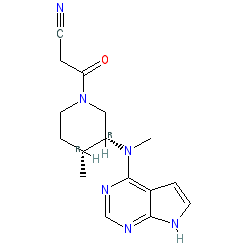|
Synonyms: CP-690,550 | CP-690550 | tasocitinib | Xeljanz®
tofacitinib is an approved drug (FDA (2012), EMA (2017))
Compound class:
Synthetic organic
Comment: Tofacitinib is an orally active, Type-1 Janus kinase (JAK) inhibitor and it was first approved by the US FDA in 2012. Tofacitinib was originally described as a selective JAK3 inhibitor [2], but subsequent analysis has revealed it to be a pan-JAK inhibitor, with predominant JAK1 inhibition [3,5].
Ligand Activity Visualisation ChartsThese are box plot that provide a unique visualisation, summarising all the activity data for a ligand taken from ChEMBL and GtoPdb across multiple targets and species. Click on a plot to see the median, interquartile range, low and high data points. A value of zero indicates that no data are available. A separate chart is created for each target, and where possible the algorithm tries to merge ChEMBL and GtoPdb targets by matching them on name and UniProt accession, for each available species. However, please note that inconsistency in naming of targets may lead to data for the same target being reported across multiple charts. ✖
View more information in the IUPHAR Pharmacology Education Project: tofacitinib |
|
|||||||||||||||||||||||||||||||||||
| No information available. |
Summary of Clinical Use  |
| Tofacitinib was intiailly approved for the treatment of rheumatoid arthritis. Marketed formulations contain tofacitinib citrate (PubChem CID 10174505). In Feb 2016 Xelanj XR® was FDA approved as the first once-daily oral JAK inhibitor for rheumatoid arthritis. In June 2018, FDA approval was expanded to include treatment of patients with moderate to severe ulcerative colitis (UC), subsequent to results from the Phase 3 OCTAVE studies, in which treatment of UC patients with tofacitinib met all primary endpoints and induced significant disase remission [9,12-13]. Xelanj XR® is not approved for UC. A report in JCI Insight in September 2016 suggests that tofacitinib-induced immunosuppression can stimulate significant hair regrowth in patients with the autoimmune condition alopecia areata [8], although more extensive studies would need to be conducted before the drug could be approved for this indication. Click here to link to a list of tofacitinib/alopecia trials registered with ClinicalTrials.gov. |
Mechanism Of Action and Pharmacodynamic Effects  |
| Tofacitinib is a JAK3 inhibitor approved for the treatment of rheumatoid arthritis either on its own or in combination with methotrexate or other nonbiologic disease modifying antirheumatic drugs. JAKs are intracellular enzymes which transmit signals arising from cytokine or growth factor-receptor interactions on the cellular membrane to influence hematopoiesis and immune cell function, via STATs which modulate gene expression. It is believed that tofacitnib improves disease symptoms by suppressing STAT-1 dependent genes and inhibiting the production of inflammatory mediators in joint tissue. Tofacitinib modulates both innate and adaptive immune responses [7]. |
External links  |
|
For extended ADME data see the following: Electronic Medicines Compendium (eMC) Drugs.com European Medicines Agency (EMA) |









